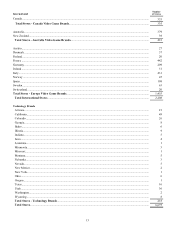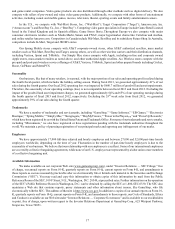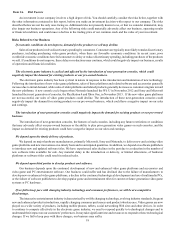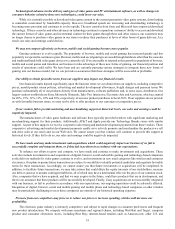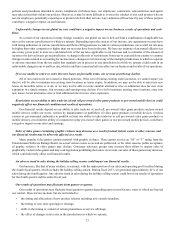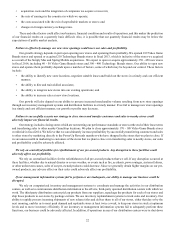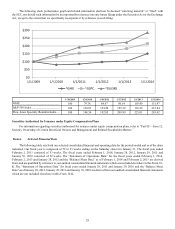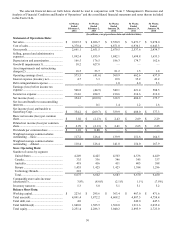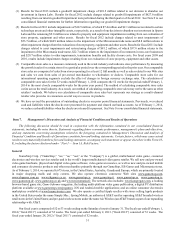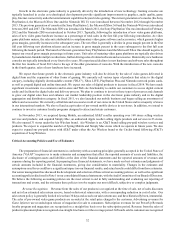GameStop 2013 Annual Report Download - page 39
Download and view the complete annual report
Please find page 39 of the 2013 GameStop annual report below. You can navigate through the pages in the report by either clicking on the pages listed below, or by using the keyword search tool below to find specific information within the annual report.22
• acquisition costs and the integration of companies we acquire or invest in;
• the mix of earnings in the countries in which we operate;
• the costs associated with the exit of unprofitable markets or stores; and
• changes in foreign currency exchange rates.
These and other factors could affect our business, financial condition and results of operations, and this makes the prediction
of our financial results on a quarterly basis difficult. Also, it is possible that our quarterly financial results may be below the
expectations of public market analysts.
Failure to effectively manage our new store openings could lower our sales and profitability.
Our growth strategy depends in part upon opening new stores and operating them profitably. We opened 109 Video Game
Brands stores and opened or acquired 218 Technology Brands stores in fiscal 2013, which is inclusive of the stores we acquired
as a result of the Simply Mac and Spring Mobile acquisitions. We expect to open or acquire approximately 350 - 450 new stores
in fiscal 2014, including 40 - 50 Video Game Brands stores and 300 - 400 Technology Brands stores. Our ability to open new
stores and operate them profitably depends upon a number of factors, some of which may be beyond our control. These factors
include:
• the ability to identify new store locations, negotiate suitable leases and build out the stores in a timely and cost efficient
manner;
• the ability to hire and train skilled associates;
• the ability to integrate new stores into our existing operations; and
• the ability to increase sales at new store locations.
Our growth will also depend on our ability to process increased merchandise volume resulting from new store openings
through our inventory management systems and distribution facilities in a timely manner. If we fail to manage new store openings
in a timely and cost efficient manner, our growth or profits may decrease.
Failure to successfully execute our strategy to close stores and transfer customers and sales to nearby stores could
adversely impact our financial results.
Our strategy includes closing stores which are not meeting our performance standards or stores at the end of their lease terms
and transferring sales to other nearby GameStop locations. We plan to close approximately 170 - 180 Video Game Brands stores
worldwide in fiscal 2014. We believe that we can ultimately increase profitability by successfully transferring customers and sales
to other stores by marketing directly to the PowerUp Rewards members who have shopped in the stores that we plan to close. If
we are unsuccessful in marketing to customers of the stores that we plan to close or in transferring sales to nearby stores, our sales
and profitability could be adversely affected.
We rely on centralized facilities for refurbishment of our pre-owned products. Any disruption to these facilities could
adversely affect our profitability.
We rely on centralized facilities for the refurbishment of all pre-owned products that we sell. If any disruption occurred at
these facilities, whether due to natural disaster or severe weather, or events such as fire, accidents, power outages, systems failures,
or other unforeseen causes, sales of our pre-owned products could decrease. Since we generally obtain higher margins on our pre-
owned products, any adverse effect on their sales could adversely affect our profitability.
If our management information systems fail to perform or are inadequate, our ability to manage our business could be
disrupted.
We rely on computerized inventory and management systems to coordinate and manage the activities in our distribution
centers, as well as to communicate distribution information to the off-site, third-party operated distribution centers with which we
work. The third-party distribution centers pick up products from our suppliers, repackage the products for each of our stores and
ship those products to our stores by package carriers. We use inventory replenishment systems to track sales and inventory. Our
ability to rapidly process incoming shipments of new release titles and deliver them to all of our stores, either that day or by the
next morning, enables us to meet peak demand and replenish stores at least twice a week, to keep our stores in stock at optimum
levels and to move inventory efficiently. If our inventory or management information systems fail to adequately perform these
functions, our business could be adversely affected. In addition, if operations in any of our distribution centers were to shut down



